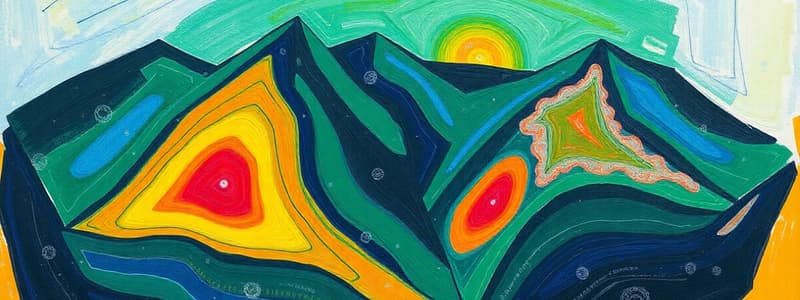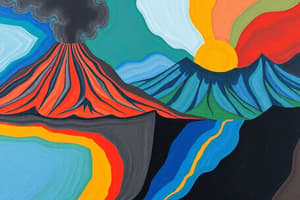Podcast
Questions and Answers
What type of crust is characterized as thicker and less dense, floating over oceanic crust?
What type of crust is characterized as thicker and less dense, floating over oceanic crust?
- Asthenospheric Crust
- Lithospheric Crust
- Oceanic Crust
- Continental Crust (correct)
Which type of tectonic plate is typically younger, thinner, and denser?
Which type of tectonic plate is typically younger, thinner, and denser?
- Oceanic Crust (correct)
- Mantle Plate
- Continental Crust
- Lithospheric Plate
What geological feature is typically arranged in a line connected by high ground, often in proximity to volcanoes?
What geological feature is typically arranged in a line connected by high ground, often in proximity to volcanoes?
- River Systems
- Plateaus
- Mountain Ranges (correct)
- Desert Plains
What phenomenon is foundational to the movement of lithospheric plates?
What phenomenon is foundational to the movement of lithospheric plates?
Which layer of the Earth is solid but can be molded, lying beneath the lithosphere?
Which layer of the Earth is solid but can be molded, lying beneath the lithosphere?
Which of the following accurately describes volcanic activity classification?
Which of the following accurately describes volcanic activity classification?
What is the primary characteristic of the lithospheric plates?
What is the primary characteristic of the lithospheric plates?
Where are earthquakes most likely to occur based on their distribution?
Where are earthquakes most likely to occur based on their distribution?
What does the Volcanic Explosivity Index (VEI) measure?
What does the Volcanic Explosivity Index (VEI) measure?
Which method is used to locate the epicenter of an earthquake?
Which method is used to locate the epicenter of an earthquake?
What is the primary focus of the National Disaster Risk Reduction Framework?
What is the primary focus of the National Disaster Risk Reduction Framework?
What does 'community-based disaster and risk management' focus on?
What does 'community-based disaster and risk management' focus on?
Which term refers to an unbiased analysis of information related to social sciences?
Which term refers to an unbiased analysis of information related to social sciences?
What defines a society in this context?
What defines a society in this context?
What do primary and secondary sources refer to in research?
What do primary and secondary sources refer to in research?
What is the main purpose of disaster management?
What is the main purpose of disaster management?
What is resilience in the context of communities facing disasters?
What is resilience in the context of communities facing disasters?
Which of the following best defines vulnerability in this context?
Which of the following best defines vulnerability in this context?
What does a vulnerability assessment evaluate?
What does a vulnerability assessment evaluate?
What is the primary purpose of hazard assessment?
What is the primary purpose of hazard assessment?
What does convergence of two oceanic crustal plates lead to?
What does convergence of two oceanic crustal plates lead to?
What is indicated by divergent boundaries in plate tectonics?
What is indicated by divergent boundaries in plate tectonics?
Which of the following is a possible outcome of a tectonic plate's leading edge flicking upward?
Which of the following is a possible outcome of a tectonic plate's leading edge flicking upward?
What is one of the geological features formed by divergent boundaries?
What is one of the geological features formed by divergent boundaries?
What is the main focus of the bottom-up approach in disaster management?
What is the main focus of the bottom-up approach in disaster management?
Which method evaluates the capability of a community to face environmental challenges?
Which method evaluates the capability of a community to face environmental challenges?
What term refers to the permanent destruction of forests due to human activity or natural calamities?
What term refers to the permanent destruction of forests due to human activity or natural calamities?
Which of the following best describes disaster preparedness?
Which of the following best describes disaster preparedness?
What is characterized by waste that comes from households and commercial establishments?
What is characterized by waste that comes from households and commercial establishments?
What does disaster response include?
What does disaster response include?
What is the result of hazard mapping?
What is the result of hazard mapping?
What does the term 'loss' refer to in disaster management?
What does the term 'loss' refer to in disaster management?
What is the primary characteristic of mid-ocean ridges?
What is the primary characteristic of mid-ocean ridges?
Which theory describes the process that leads to the formation of new oceanic crust?
Which theory describes the process that leads to the formation of new oceanic crust?
Which process is responsible for creating fault lines and rift valleys?
Which process is responsible for creating fault lines and rift valleys?
What evidence did scientists use to support the Continental Drift Theory?
What evidence did scientists use to support the Continental Drift Theory?
Who is credited with proposing the idea of Continental Drift?
Who is credited with proposing the idea of Continental Drift?
Which statement about rift valleys is true?
Which statement about rift valleys is true?
What happens to the molten magma that erupts at mid-ocean ridges?
What happens to the molten magma that erupts at mid-ocean ridges?
What is a characteristic feature of the San Andreas Fault?
What is a characteristic feature of the San Andreas Fault?
Study Notes
Plate Boundaries and Tectonic Processes
- Plate boundaries are lines at the edges of different lithospheric pieces.
- Volcanoes release ash, magma, and lava through a crater; can be active, dormant, or extinct.
- Mountain ranges often form near volcanic sites and are aligned with high ground.
Types of Crust/Tectonic Plates
- Continental Crust: Outermost, thicker, less dense, floats over oceanic crust due to buoyancy.
- Ocean Crust: Thinner, denser, forms the seafloor; younger than continental crust and sinks due to lower buoyancy.
Major Tectonic Plates
- Seven large tectonic plates include African, Antarctic, Eurasian, North American, South American, Indo-Australian, and Pacific Plates.
- Earthquake distribution tends to occur in narrow zones, particularly at continental edges.
Earth's Internal Layers
- Mantle: Layer of silicate rock between the crust and outer core, responsible for convection currents.
- Lithosphere: Solid outer part of Earth, forms tectonic plates.
- Asthenosphere: Upper layer of mantle, solid but moldable; convection occurs here.
Geological Events
- Convergent Boundaries: Interaction between plates leads to volcanic arcs, earthquakes, and subduction zones.
- Divergent Boundaries: Plates move apart, creating mid-ocean ridges, rift valleys, and shallow earthquakes.
- Transform Fault Boundaries: Plates slide past each other, forming fault lines (e.g., San Andreas Fault).
Earthquake Detection and Characteristics
- Geophysical hazard maps show areas prone to geological hazards.
- Volcanic Explosivity Index (VEI) measures eruption explosiveness.
- Triangulation method locates earthquake epicenters.
Disaster Management Concepts
- National Disaster Risk Reduction Framework: Preparedness guidelines for nations and communities during hazards.
- Community-Based Disaster and Risk Management (CBDRM): Involves local cooperation in disaster planning and response.
- Disaster Preparedness: Actions undertaken before and during disasters to minimize damage.
Key Environmental Issues
- Climate Change: Increasing frequency and intensity of natural disasters.
- Deforestation: Long-term destruction of forests, affecting ecosystems.
- Solid Waste Problem: Increasing plastic pollution and waste management challenges.
Theories of Earth's Movements
- Continental Drift Theory: Proposed by Alfred Wegener; Pangaea broke into Laurasia and Gondwanaland, explaining the geological fit of continents.
- Sea Floor Spreading: New oceanic crust forms at mid-ocean ridges; evidence includes magma eruption and magnetic stripes on the ocean floor.
Studying That Suits You
Use AI to generate personalized quizzes and flashcards to suit your learning preferences.
Description
This quiz covers the various plate boundaries, processes, and landforms associated with the convergence of tectonic plates. Understand the distinction between volcanic formations and different types of Earth's crust, including the continental crust. Test your knowledge on how these elements interact within the lithosphere.




